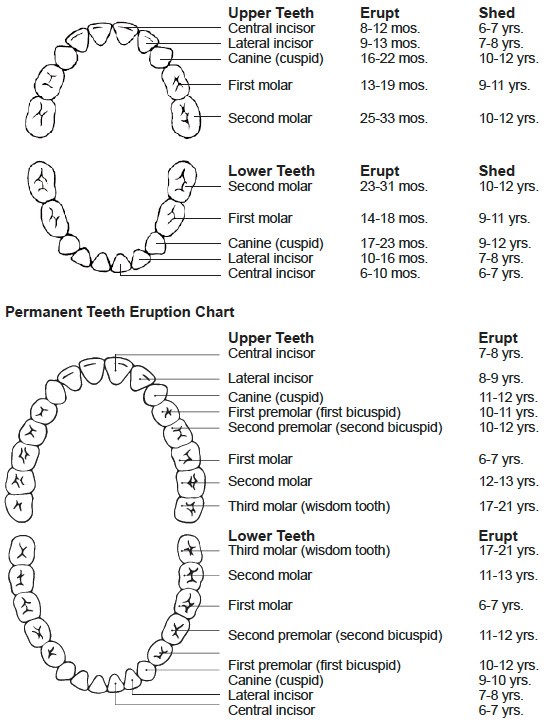As an orthodontist I am often asked questions from worried parents about teeth that haven’t grown in yet. As parents we have all been there in one way or another – our child’s friends may seem to walk, talk, throw a ball, or lose a tooth earlier than our child and we want to make sure there is no cause for concern. We want to be assured we are giving our children all the care they need to be successful in life. There is nothing wrong with this and it’s only natural to want to be certain that all is well.
When it comes to tooth eruption, there can be significant variation from one child to another. Below you will see a diagram created by the American Dental Association that gives a pretty good guideline for when normal eruption patterns usually occur. However, 6-12 months beyond the guidelines below would still fall into what I would consider a very normal range.

There are two main reasons why there is such a wide age range for normal tooth eruption. First would be the fact that girls tend to develop physically faster than boys on average. It is not uncommon in my orthodontic office to see girls who have lost all their baby teeth and have all their permanent teeth (with the exception of wisdom teeth) erupted by age 9 or 10. It is also not uncommon to see boys who still have permanent teeth that have not erupted at age 14 or 15. The second main reason for a wide age range of permanent tooth eruption is genetic variation. Among both boys and girls you will find “late bloomers” or precocious growers. This does not indicate there is something wrong, just that we are all unique.
While most cases of teeth “growing in late” are harmless, there are situations where there may be some cause for concern. One of the most common I see as an orthodontist is a permanent tooth growing in “on top” of a baby tooth that was supposed to be “pushed out” by the permanent tooth but seems to be anchored firmly in place. This situation can cause the permanent tooth to grow into a much different position than it normally would and further disrupt the sequence of eruption for other teeth that still need to grow in. We refer to this situation as ectopic eruption. Usually I would want to have the child’s dentist “wiggle out” the baby tooth so that the permanent tooth can grow into its proper position. Another common situation orthodontists encounter is baby teeth that are present long after their counterpart on the other side of the mouth has exfoliated. This is usually indicative of a more serious problem – that child is usually either congenitally missing a tooth (born without it) or has an impacted tooth (the tooth is stuck and can’t erupt). These situations almost always benefit from orthodontic intervention.
If you are concerned about your child’s dental development, follow the recommendation of the American Association of Orthodontists and have your child evaluated by an orthodontist at age 7. By this age, permanent teeth are starting to erupt and problems that might become severe in the future can often be treated early with a more simple solution. Please come visit us at Budd Orthodontics for a complimentary consultation to learn more about orthodontic treatment for your child.







 Website Powered by Sesame 24-7™
Website Powered by Sesame 24-7™